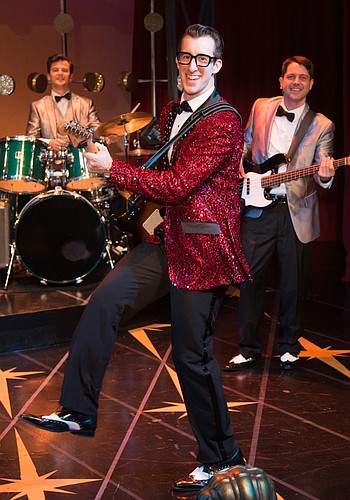- January 2, 2025
-
-
Loading

Loading

As Don McLean fans know, a plane crash silenced Buddy Holly on Feb. 3, 1959 — the “Day the Music Died.” Along with the pilot, that crash also took the life of Ritchie Valens, and Jiles Richardson Jr., (aka “The Big Bopper”). What songs would these musicians have created if they’d taken the bus instead? We’ll never know. But Alan Janes’ “Buddy: The Buddy Holly Story” fills the air with Hollies hits — with a few by Valens, Richardson and others thrown in for good measure.
Janes’ 1989 smash was one of the first jukebox musicals. There’s no jukebox here, but there are plenty of great musicians. (Who can also act.)
In Michael Perrie Jr.’s portrayal, Buddy Holly doesn’t have a mean bone in his body — though he does play a mean guitar. Drummer Seth Eliser, guitarist Armando Gutierrez, and bassist (and music director) Spiff Wiegand, all nicely embody Holly’s nascent band — The Crickets. They’re excellent at both characters and chords. When Ryan Halsaver isn’t portraying “Hipockets,” (the Texas DJ who gave Holly his first radio airtime), he’s singing and wailing on sax. Danielle Erin Rhodes is inventive and sprightly as pianist Vi Petty. Jimmy Lewis and Armando Gutierrez burn up the stage as The Big Bopper and Ritchie Valens. Jannie Jones and Troy Valjean Rucker are equally sizzling in a few R&B numbers. These talents all play various characters — and all sing and play backup, as the musical requires. Which is most of the time …
This show does have a story, but it’s lean-and-mean. (The music/story ratio is about 90-10%.) That said, the musical’s stripped-down story is pretty interesting. Holly has a Mr. Nice Rocker reputation — a polite kid with thick black plastic glasses who could sing and play. This musical contextualizes Holly as a musical innovator, who would smile his infectious, boyish grin and do things his own way. The first act shows the songs he created with The Crickets as works-in-progress.
Holly doesn’t have it down to a formula: he’s working out chords and changes as he goes along. You also discover that Holly stepped away from a future career as a country music superstar at a time when rock was risky — and considered “race music” by mainstream white radio stations. The decisive Holly also doesn’t think twice about proposing to Maria Elena (Monica Rodrigues) — five hours after meeting her for the first time. She’s a Latina beauty. Holly calls his Mother back in Lubbock, Texas, to give her the good news. She objects for racist reasons. Holly politely ends the call.
Interesting character insights abound in the story. But they’re essentially liner notes, and not the main attraction. This show is all about the music.
The aforementioned musicians are excellent. The music is, too. The show’s euterpean talents groove nicely on the usual suspects. Fifties fans would probably riot if FST deprived them of Holly’s hits. But “Peggy Sue,” “That’ll Be the Day,” “Maybe, Baby” and “Raining in My Heart” and the like are all duly represented. You’ll also hear The Big Bopper’s and Richie Valens’ chart-toppers ("Chantilly Lace,” and “La Bamba,” respectively.) On top of that, the “Showtime at The Apollo” segment delivers sizzling renditions of The Isley Brothers’s “Shout” and other R&B classics.
The show’s talented actor/musicians dial it up to 11 — and never dial it down. Props also to Susan Angermann’s costumes, Rodrigues’ choreography and Axis Studios’ set design. Their work beautifully captures the look-and-feel of the late 1950s. (Wiegand’s Cirque de Soleil-style gyrations on the upright bass detract from that. His athletic moves are vastly entertaining — but not of the time.)
Director Jason Cannon and music director Wiegand take a music hall approach with the show’s material. (Fair disclosure: Sing-alongs are not my cup of tea. I’d rather hear the pros, OK?) But that’s what the people want, and FST delivers.
On the night I saw this musical, I did a quick survey of the happy folks around me.
I’d estimate the vast majority of the audience actually remembers when rock was young. This show clearly brought back those memories. They were hopping and bopping along in their seats. The Gompertz has no dance floor …
If it had — they would’ve filled it in an instant.